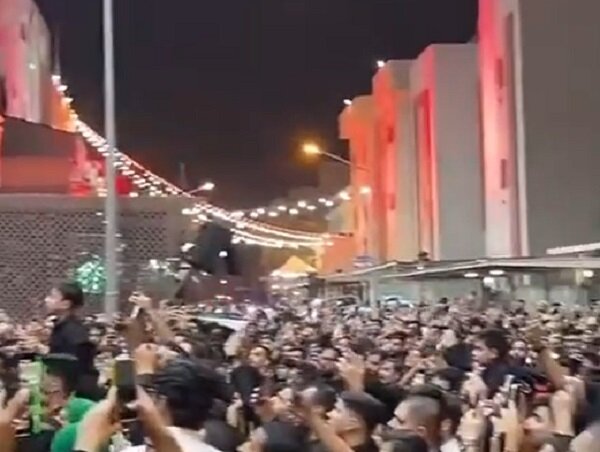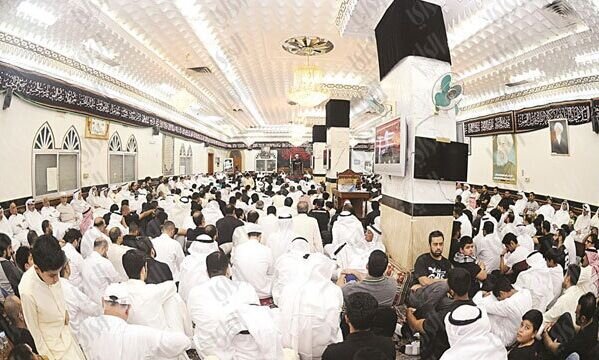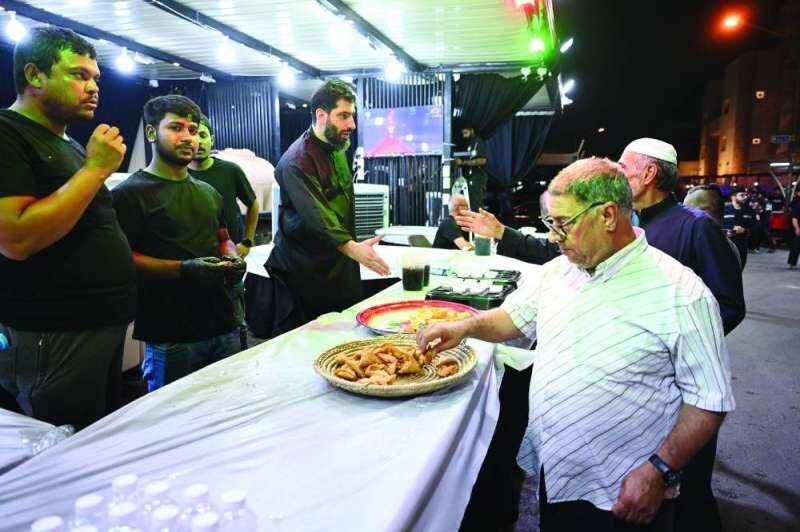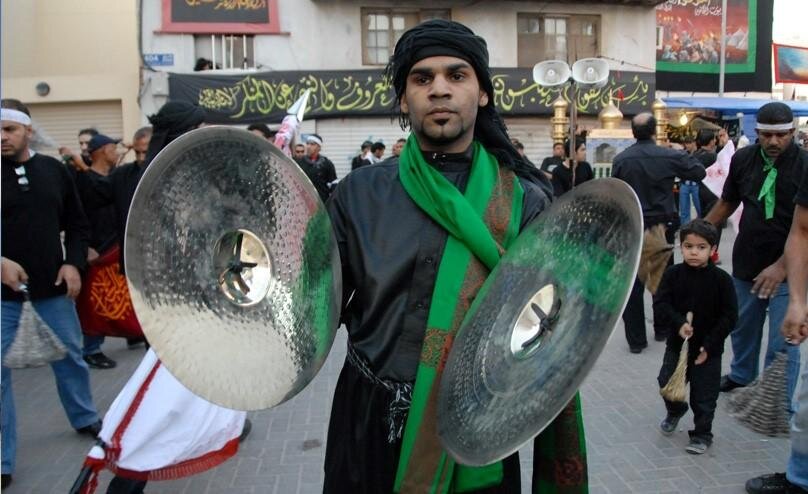Muharram in Kuwait; From the presence of Sunnis next to Shiites to the restrictions of mourning

news Mehr , groupbetween Ellam, Elnaz RahmatNejad: the interior areas of Kuwait, including Al-Dasmah, Al-Daiya, Al-Shaab, Banidul Qar, Al-Swabar, Al-Ramithiyah, Al-Salmiyah, Al-Mansooriyah, Sabah Al-Salam, Al-Zahra and Al-Shahada every year with On the way to the month of Muharram, they experience heavy traffic and congestion. The reason for this traffic is the abundance of Shiite residents and the number of Hussainiyya and Takaya after Maghrib and Isha prayers.
The hustle and bustle in these Hosseiniyehs reaches such an extent that the pedestrian bridges, parks and lands around the Hosseiniyehs are filled with mourners of Aba Abdullah (AS). Hussainiyyas, especially Hussainiyyah al-Kazamiyyah (al-Baqa) and al-Zalzaleh, hold three times of speeches and mourning in different languages, Arabic, Persian, English, and sometimes French and German, for those who do not master the Arabic language.
At the same time with the arrival of Muharram 1446, we introduced mourning habits and customs in the Islamic world.
The first to third part of this report, which is dedicated to mourning habits and customs in Lebanon, Pakistan and Iraq, can be read and reviewed from the following links:
* “Mahram in Lebanon; from ceremony prayer Party Allah in Suburb To recitation at Nabatieh”
* “Mahram in Pakistan; Fromthe symbolic ceremony “Zul-Janah” to Ship “Ship Salvation”
* «Moharram Hosseini’s riot in Iraq; From the ceremony of changing the flag to the “Rakzah Toweerij”
In the following, we read the detailed fourth part of this case, which deals with mourning habits and customs in Kuwait;
From free travel for those who have not been to Karbala to the proposal to name Orphan Day
Ceremonies of a number of hosseiniyehs and takiyas in Kuwait are held simultaneously for brothers and sisters, some separately and some for women. A group of Hosseiniyehs also prepared to deliver 4 and 5-year-old children during the Muharram decade by announcing on social interaction sites and publishing advertisements in mosques and religious centers in the weeks before the beginning of Muharram and holding various religious activities for them. informed so that their families can participate in the mourning ceremony with peace of mind.
Some other newly established religious centers have announced their events especially for young people and during the nights of Muharram decade, the uprising of Imam Hussain (peace be upon him) and the events of Ashura with the help of religious experts. explain Donating free trips to shrines by pilgrimage caravans for people who have not been able to travel to these places is one of the other aspects of mourning ceremonies in Kuwait.
In the past few years, a number of Hussainiyas have suggested that the 8th night of Muharram, which coincides with the martyrdom of Hazrat Ali Asghar, be named Orphan Day. Spreading the spirit of social solidarity and sympathy for orphans who have lost their family and love is one of the goals of this naming.
Mourning ceremonies of Rasool-e-Azam Al-Karbalaiyya, Al-Bohamd, Al-Saffar, Al-Nazhad, Bibi Rabab, Ashura and Muslim Ibn Aqeel are held from the beginning of the month of Muharram to the end of the month of Safar. The number of mosques, takayas and hosseiniyehs such as Seyyed Mojtabi Al-Mahri, Ashkananiyeh, Muhammad Zaghan Sharq, Diwaniyeh, Mirzai Shirazi, Shaban, Ashak al-Hussein (PBUH), Ali Akbar and Bibi Rabab, which hold their ceremonies in Persian, is increasing every year. It has been.
Husseiniyeh of Al-Ardiya region, affiliated to Indian Ismaili Shiites, holds its ceremonies in the month of Muharram with the presence of elders of its religion in Urdu language. More than 10,000 Ismaili Shiites living in Kuwait mourn the Muharram decade by gathering in this Hosseiniyya and wearing white clothes and sweatpants. Sayyid al-Shaheda (AS) is mentioned in all annual Shiite ceremonies, from mourning and weddings to the zikr after their prayers. After their prayers, they express their sympathy and love to that Prophet by hitting their chest with their palms.
Media coverage of mourning; From local newspapers to Kuwait’s official TV
The local newspapers and satellite channels of this country reflect the mourning ceremonies of Hosseiniyehs and Takiyas in detail. Shia satellite channels, including Alkot, Al-Anwar 1 and 2, Al-Adalah, Al-Mahdi and Al-Maarif broadcast this ceremony live. Some non-governmental satellite channels of Kuwait Al-Watan broadcast parts of this ceremony in their news sections every day. Kuwait’s official television also devotes a part of its evening programs to the speech of a Shia cleric.
The other press of this country covers the ceremony extensively by dedicating front and inside pages and inserting detailed analytical and historical articles and printing video reports of mourning. With the beginning of the month of Muharram, many Kuwaiti authors write their articles about the uprising and the philosophy of Ashura, and the pages of Al-Watan, Al-Quaitiyeh, Al-Rai, Nahar, Al-Anba and Al-Qabas newspapers also reflect the mourning gatherings on a daily basis.
Blood donation instead of machete
Blood donation is done instead of machete in a number of Kuwait’s Hussainiyya. A number of local newspapers reflect the reports and pictures of Hosseini’s mourners who are donating blood instead of machete. Also, many Shiite elders advise the bereaved to donate blood to the sick by sending text messages.
feeding the mourners; From Ali Asghar’s tent to girls’ caravan
Mourners are fed by distribution of hot and cold drinks and offerings. Khimeh Ali Asghar has attracted the attention of many Sunni citizens and foreign nationals living in Kuwait with its many branches in different areas of Kuwait that distribute fast food. In addition to this tent, girls’ caravan, Al-Ghadir, Muzaif Al-Hussein and Abi Abdullah Al-Hussein tent are salawati stations in Kuwait, where all kinds of ice cream, hot and cold drinks, sandwiches and traditional foods are distributed. Iranians welcome mourners by setting up mobile salutation stations in the areas of Benid al-Qar, Al-Salmiya and Al-Ramithiya.
Muharram in Kuwait is not exclusive to Shiites
Muharram in Kuwait is not exclusive to Shiites, and many Sunnis attend the occasions of these days, especially the seventh night of Muharram, the day of martyrdom of Hazrat Abul Fazl (AS) and the day of Ashura. A number of Sunni mourners show their interest in Hazrat Seyyed al-Shaheda (AS) by offering sacrifices and offerings and receiving the mourners or sending food to the Hosseiniyya.
On the nights of the 7th, 8th, 9th, and 10th of Muharram, some Hosseiniehs add chains to their ceremonies in addition to the chest ceremony, and mourning groups are held outside the Hosseinieh for a period of They start chaining and then enter the Hosseinieh due to legal restrictions. In advance, groups of black flags and Ashura slogans are waving. Some groups are also playing cymbals and drums. The Martyrdom Theater performance of Hazrat Abul Fazl (a.s.), Hazrat Qasim, Ali Asghar and Imam Hossein (a.s.) is performed in many Hosseiniyehs during the last nights of the decade of Muharram, and this theater is an inseparable part of these ceremonies.
Lighting a red light as a sign of mourning
Many Shiites of Kuwait spend the night of vigil and reviving the 9th night, the morning of Ashura with bare feet, sometimes rubbing flowers on their heads and tying green and black bands on their foreheads and wearing clothes Siah goes to the Hosseiniehs and spends the 11th night as a stranger’s dinner, reviving and lighting candles and red lights as a sign of mourning. The windows of the cars are also decorated with flowers as a sign of mourning, and black flags are installed on the cars.
Reading the Muqtal and performing the noon prayer of Ashura
The death of Hazrat Seyyed al-Shaheda (AS) has been heard from the external loudspeakers of mosques, takayas and hosseiniyehs since the early hours of the morning, and many black-clad families holding Hosseini flags from Relatively foreign areas are sent on foot to the Hosseiniyehs of the Shiite areas.
Ashura noon prayer is also held immediately after reciting Maktal and mourning. In addition to mourning in the hosseiniyehs of Iranians and some takayas, the Ashura ceremony is held every year by the cultural consultancy of Iran and the supervision of schools of Iranians living in Kuwait and other institutions.
Limitations of mourning ceremony
Abba Abdullah (PBUH) mourning ceremonies in Kuwait have a long history and even during the outbreak of the virus Corona has also been held. Also, the establishment of Hosseinieh in Kuwait has a historical depth and Al Sabah family played an important role in the establishment of the first Hosseinieh. But recently, restrictive laws were implemented regarding the holding of Muharram mourning ceremonies for the Shiites of this country. On Monday, July 18, coinciding with the first day of Muharram, 1446, the Ministry of Interior of Kuwait announced that the owners of the Hosseiniyas do not have the right to raise the Hosseinian flags and processions on the days of Muharram and Safar, and threatened the Shiites against holding mourning processions in the streets and other public places. For this reason, the ceremony of raising the mourning flag of Seyyed al-Shaheda (AS) in Kuwait was held in one of the main mosques of the capital of this country, despite the obstruction, with the large presence of Kuwaitis under strict security measures.
The Ministry’s statement in a post on Platform X states: “Hosseinieh owners must adhere to regulatory laws and the orders of the security forces in order to maintain everyone’s safety. It is allowed to install only one flag without a slogan on Hosseiniyeh. It is strictly forbidden to place any tents and booths outside the Hosseinieh wall for any reason. It is also forbidden to hold any kind of march. Anyone who does not adhere to the regulatory rules will be dealt with severely.”
Immediately after the issuance of this order, the security forces of Kuwait and the municipality began to collect the flags, flags and other symbols of the Husseiniyas, which caused Kuwaiti citizens to react and confront the government agents. . Also, the protests of these citizens can be seen on social networks, especially Facebook.
Clips were circulated on social networks showing the anger of the Kuwaitis over this decision. In one of these clips, a citizen came to the street shouting against this decision and chanted: “Hossein’s house is my house… Hossein is my grandfather”. Another clip published on platform X shows a citizen talking about the obstruction of the relevant authorities in Kuwait from granting permission to the owners of Husseini processions to hold the Ashura ceremony. This citizen said: “Every year we request from the municipality, the fire department and all the officials and we get permission for Hossein’s processions in the month of Muharram. This year, we ask the municipality and they say the minister of the interior, we ask the fire department and they say the minister of the interior, we asked everyone and they say the minister ordered to remove Hosseini’s processions. The ministers of the previous governments of Kuwait were often tolerant and cooperated with the owners of the processions and set special conditions for safety and fire extinguishing and even shared the reward of mourning Imam Hussain (peace be upon him) with us. Now the municipality and the police come unannounced and destroy the processions.
Fahd Youssef Saud Al-Sabah, the Minister of Interior of Kuwait, defended the decisions of the ministry of this country in limiting Husseini mourning in this country in Muharram 1446. He stated the reason for warning the owners of Hosseiniyehs to allow the installation of only one flag without any slogans, to prevent any accidents. Fahd Yusuf Saud Al-Sabah gives freedom to Shiites as long as they express their identity within the limits of the law.
Critics of the Ministry of Interior believe that the said statement and its orders are an attempt to limit the large Shia community of Kuwait. Meanwhile, the Shiites of Kuwait are among the original citizens of this country and have been residing in this country since its establishment.





